Probably Leopold Koppel (1854–1933), Berlin; probably Else Koppel Klotz (died 1950), Berlin and Pontresina, Switzerland; Leopold Hugo Paul Klotz (1909–1993), New York; Ruth Klotz (formerly Baroness von Riedel), New York, 1993; Estate of Ruth and Leopold Hugo Paul Klotz; sale, Christie’s, New York, September 28, 2006, lot 131
The relief, which has been backed with a new plaster support, has six prominent diagonal breaks visible across its surface. The most prominent of these runs the full width of the relief, from the Virgin’s right shoulder through her hands and the Child’s left shoulder to the sash at His waist. Another runs parallel to this through the Virgin’s right forearm and cuff to the Child’s left hand. Smaller breaks run from the right edge of the relief above the Child’s halo to His right hand; from the bottom edge through the Child’s foot to His arm; from the bottom edge below the Virgin’s right arm to her hands; from the top edge through the Virgin’s scarf; and from the right edge to the Virgin’s chin. Most of these have resulted in minor paint loss, but larger losses and discolored retouching are visible in the Virgin’s hands; at the bottom edge below the Virgin’s elbow; at the Virgin’s waist near the Child’s left hand; and in the Child’s sash. Other than these areas of total loss, the paint surface is in an exceptionally fine, unabraded state, with much of its original impasto intact. The Virgin’s halo, originally silver gilt, has oxidized to black. The mordant gilt rays emanating from it, as well as the mordant gilding of the Child’s halo, are intact but obscured by an opaque varnish coating the surface.
Cast in stucco in exceedingly shallow relief, the Virgin faces three-quarters to the right, her hands clasped in adoration of her Child. She wears a red dress covered by a blue cloak, with a white cloth and transparent veil over her blond hair. The Christ Child, seated at the right on a cushion notionally resting on the frame ledge, is portrayed in full left profile, playing with His mother’s veil and left sleeve. He wears a short white tunic belted with a blue-green sash. The background of the relief is painted blue (now degraded to black) over silver gilding, with the Virgin’s halo left in reserve as a silver disk around her head, surrounded by sgraffito silver rays that radiate outward, nearly to the edges of the relief.
This relief is among the best preserved of more than two dozen known replicas of a composition attributed to Desiderio da Settignano, or sometimes to his brother, Geri da Settignano (1422/24–1462/69). The composition, the invention of which must date to the early 1450s (see Neri di Bicci, Virgin and Child), is often referred to as the Alberti Madonna, after a supposed marble original in the Victoria and Albert Museum, London (fig. 1).1 The marble, however, is a nineteenth-century pastiche created by Giovanni Bastianini (1830–1868), as was already rumored before that gifted sculptor’s death, when the relief appeared on the art market in Paris in 1865.2 It incorporates Bastianini’s characteristic and, in this case, inappropriate imitations of models by Antonio Rossellino for his figure types;3 a misunderstanding of fifteenth-century fashion in the design of the decorative panel across the Virgin’s chest; and an anachronistic exaggeration of perspectival details in the rendering of the Virgin’s veil and, above all, in the projection of the tassled cushion on which the Christ Child is seated. Bastianini took as his prototype for the Alberti marble a pigmented stucco relief acquired by the Berlin Museums in 1842 (or another cast from the same mold) which shows the two-figure group of the Virgin and Child substantially as they appear in the Yale relief but with the addition of two modeled cherub heads filling the background at upper left and upper right (fig. 2).4 Nearly all the other stuccoes omit the cherubs but repeat the Virgin and Child with only minor variations that do not seem to reflect Desiderio’s revisions to his own composition but rather the decorative concerns of the independent painters’ studios responsible for their polychromy.
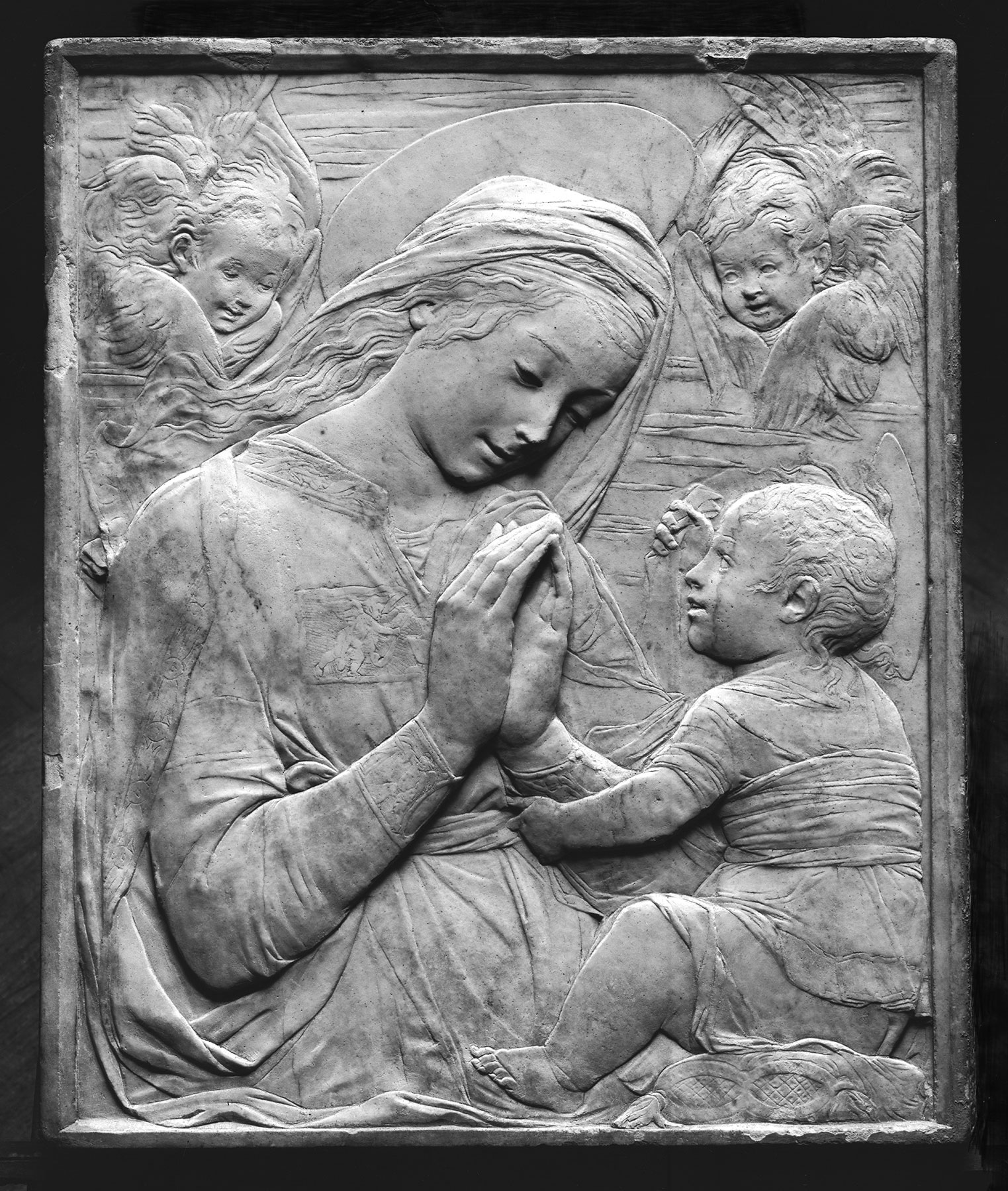
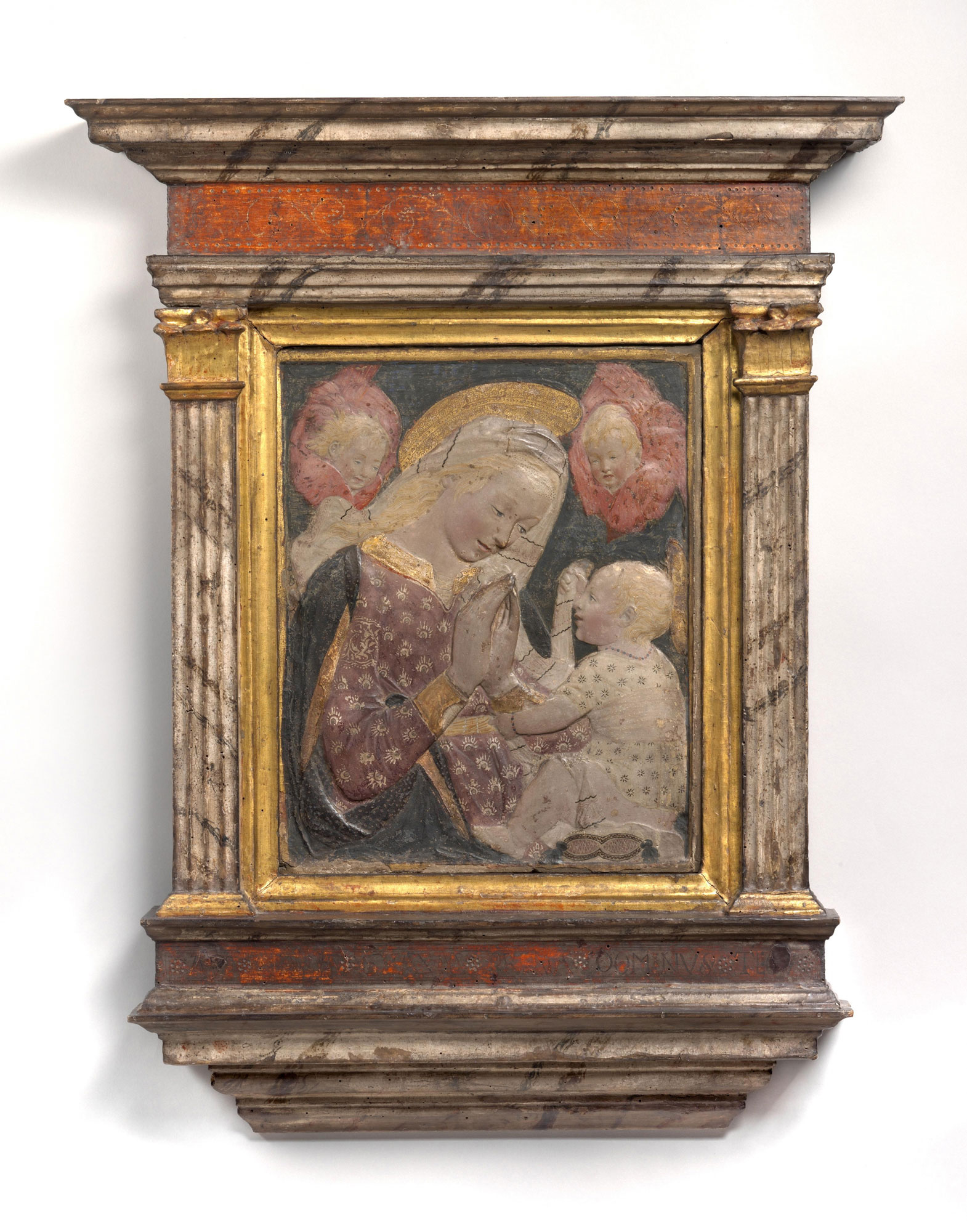
The present relief was assumed to have been painted and gilt by Neri di Bicci when it was acquired for the Yale University Art Gallery in 2006. At that time, it was conventionally supposed that all the surviving reliefs of the “Alberti” type were produced in the workshop of Neri di Bicci, based on the frequency with which his Ricordanze note the sales of low-relief gesso casts of the Virgin and Child. In fact, only eight known examples can be attributed to Neri di Bicci; the others are to be ascribed to at least two, possibly more, different artists. One of these other artists was recognized as the Pseudo-Pier Francesco Fiorentino (also known by the variant descriptor “Lippi-Pesellino Imitators”) by Giancarlo Gentilini in 2007, when he associated that name with two examples of the “Alberti” composition formerly on the art market.5 The Yale relief was first directly attributed to the Pseudo-Pier Francesco Fiorentino by Giada Petrillo, in an email communication of January 3, 2014, and this attribution is correct. There are seven known versions of the “Alberti” relief pigmented by the Pseudo-Pier Francesco Fiorentino:
-
(b) the present relief;
-
(c) Sotheby’s, Amsterdam, 2006;7
-
(d) formerly art market, Florence;8
-
(e) formerly Volpi collection, Florence;9
-
(f) Semenzato, Venice, 2002;10
-
(g) formerly(?) Museum Folkwang, Essen.11
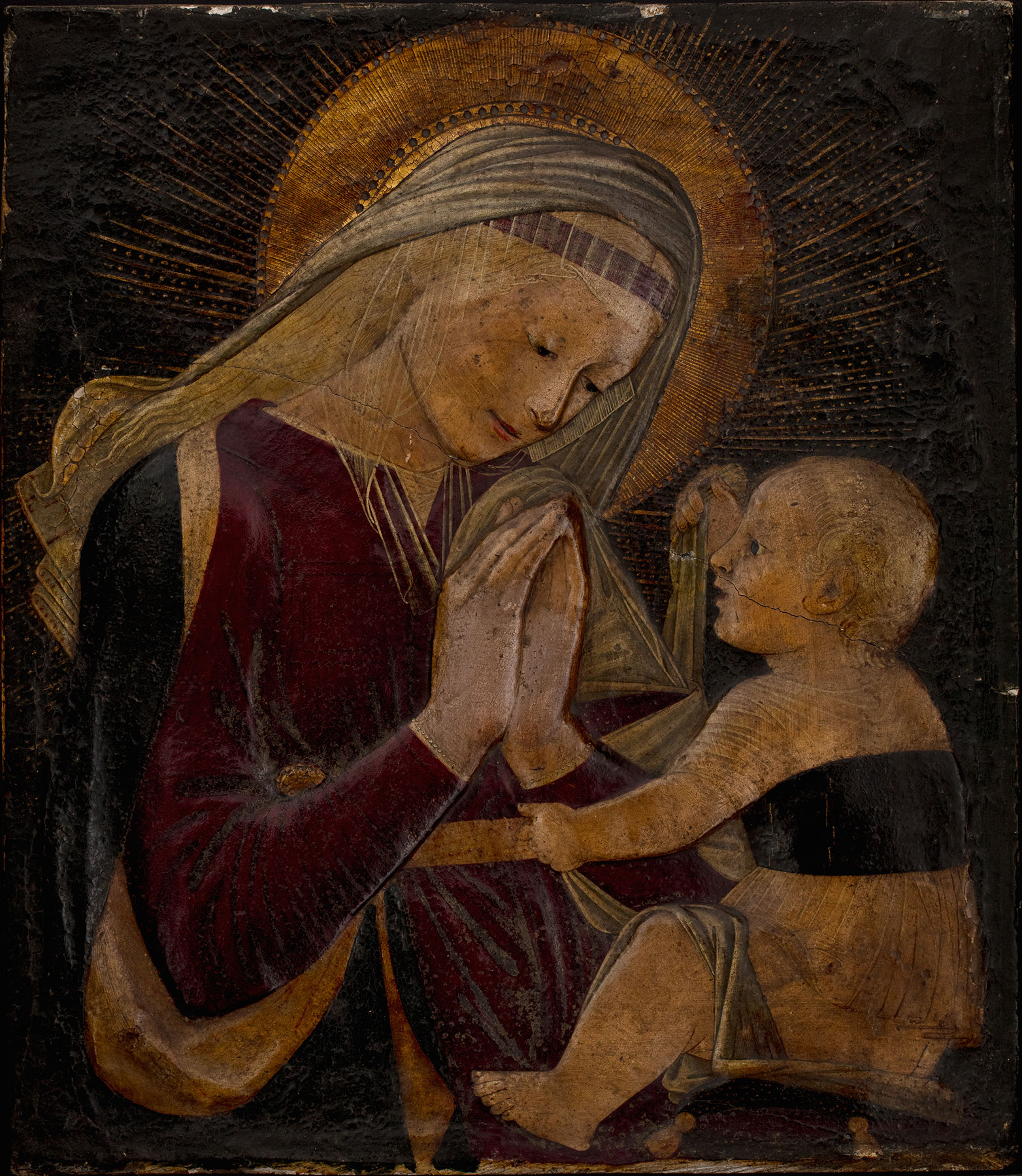
All seven of these reliefs share several features that do not recur in reliefs pigmented in other artists’ workshops. Most conspicuous are the haloes of the Virgin, rendered flat against the background of the relief rather than projected in foreshortening, and the specific shape of the translucent veil that falls across her forehead, covering a red band holding her blonde hair in place. The seven share a general conformity in rendering the dress of the two figures but otherwise display minor variations in decorative details. Only two of the seven reliefs (e and f) appear to provide a gilt halo for the Christ Child. Two reliefs (d and e), both preserved with their original tabernacle frames, are extended at the top with an arched addition containing a Dove of the Holy Spirit. The best-preserved paint surfaces among the group appear to be those on the Lyon relief, the Yale relief, and the relief sold at Semenzato in Venice in 2002 (a, b, and f). The most delicately painted, and possibly the earliest of the series, is the Yale relief, which is also the only relief with a silver-gilt background rather than gold.
Assigning a chronology to paintings by the Pseudo-Pier Francesco Fiorentino is an intuitive and approximate exercise, as only one out of more than two hundred known works by him can be precisely dated (fig. 4). Assessing the polychromed stucco reliefs emerging from this studio—examples of a composition invented by Antonio Rossellino (fig. 5) have also been attributed to the Pseudo-Pier Francesco Fiorentino12—is more difficult still. None of them retain traces of underdrawing used to transfer or elaborate the cartoons on which they were based, as this function was supplied by the cast matrix; it is frequently the vitality or slackness of the underdrawing that establishes relative dating within a group of works based on the repetition of a single cartoon. It is mere speculation to suggest that the studio may have begun this type of work around 1460, when a notable decline in the frequency of Neri di Bicci’s sales of stucco reliefs might indicate that his previous monopoly of this market was challenged by another producer. The delicacy of the application of paint on the Yale relief and the precision of its silver-gilt decoration argues for its not having been executed as late as 1470, but the range of dates proposed here, ca. 1460–65, must be understood as entirely hypothetical. —LK
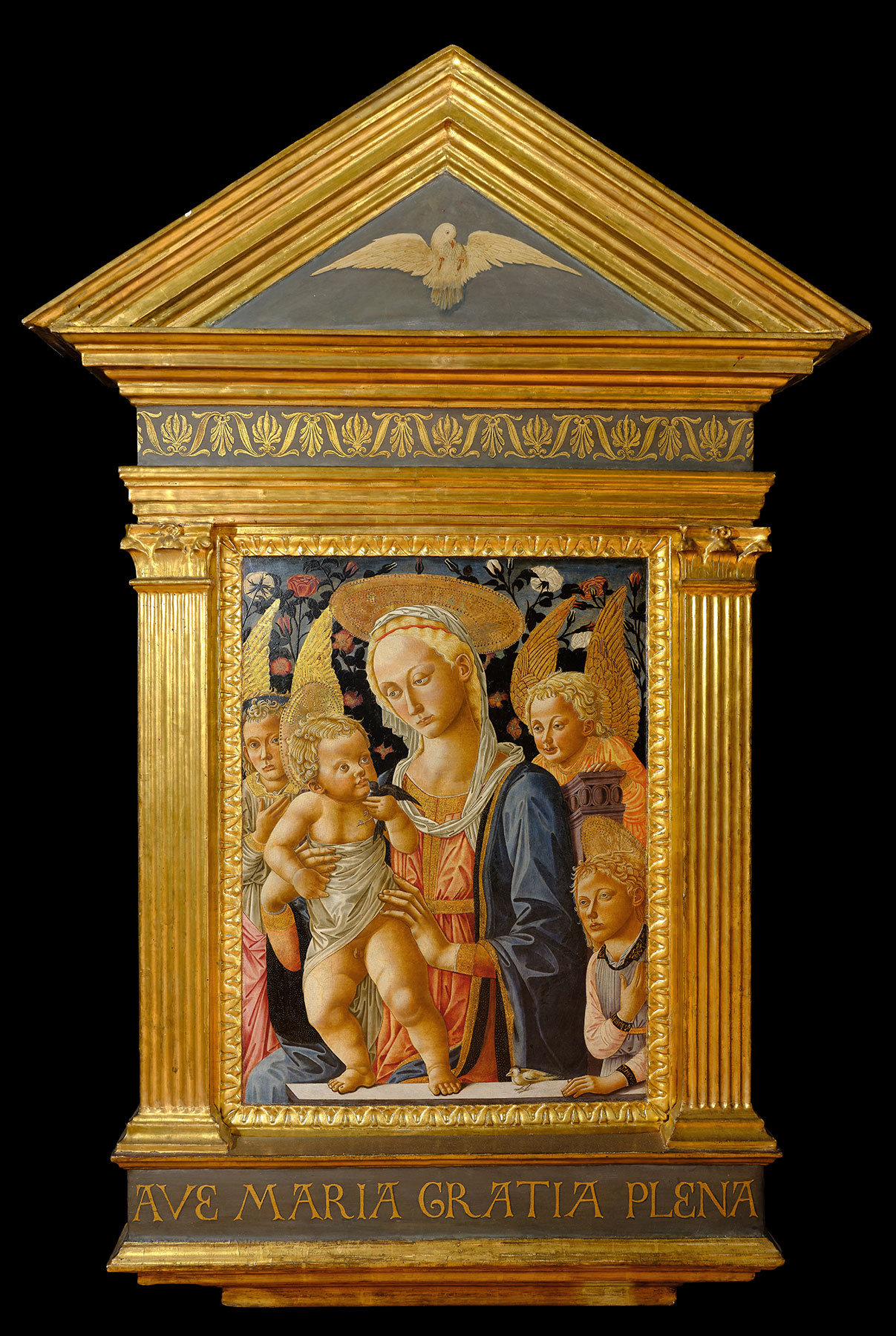
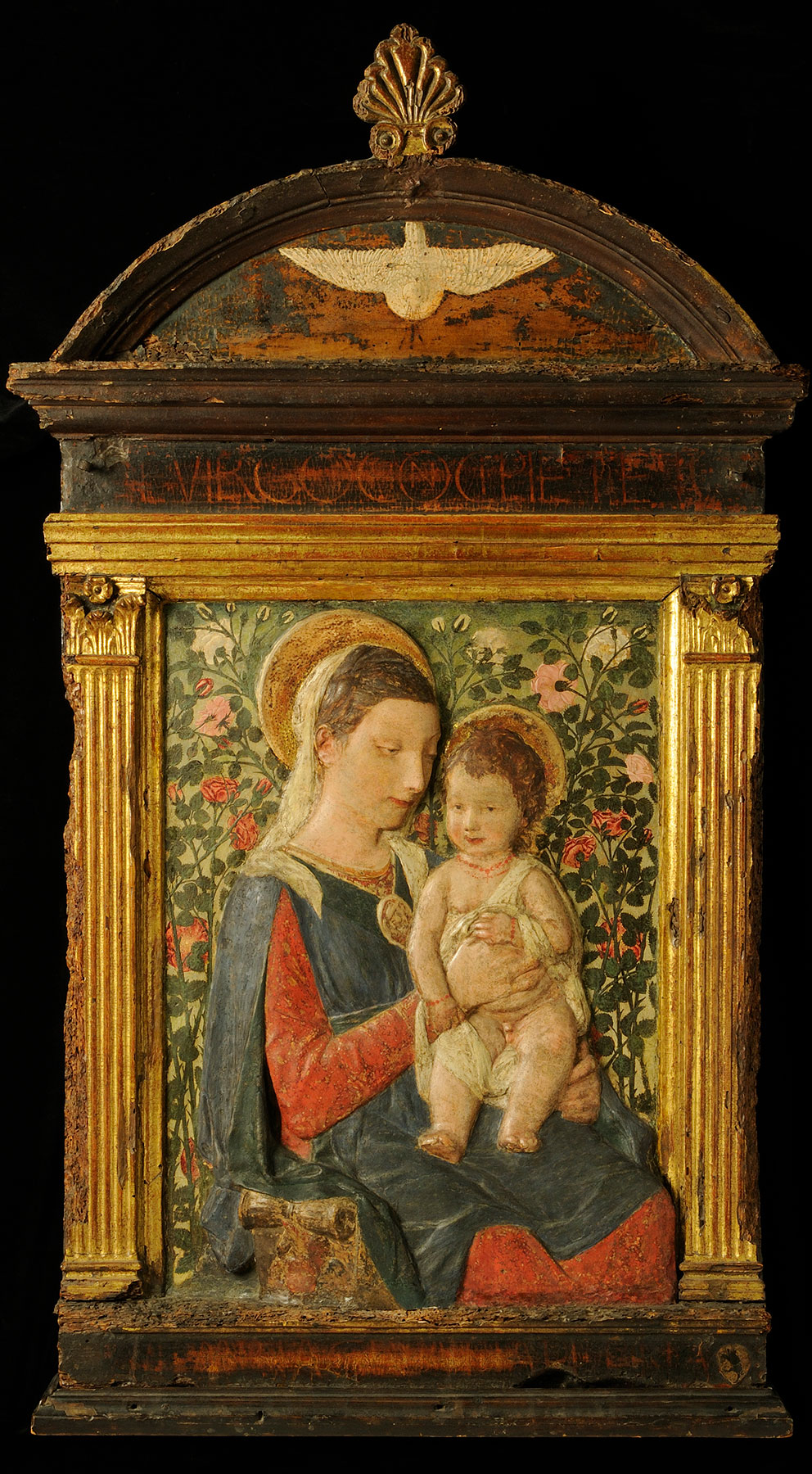
Published References
Art for Yale: Collecting for a New Century. New Haven: Yale University Art Gallery, 2007., 205; Kanter, Laurence. Leonardo: Discoveries from Verrocchio’s Studio, Early Paintings and New Attributions. New Haven: Yale University Art Gallery, 2018., 79, fig. 57
Notes
-
Pope-Hennessy, John. Catalogue of Italian Sculpture in the Victoria and Albert Museum. 3 vols. London: H. M. Stationery Off., 1964., 1:142–43. ↩︎
-
Foresi, Alessandro. Tour de Babel, ou, objets d’art faux pris pour vrais et vice versa. Paris: Pedone LaUriel, 1868., 64–66. ↩︎
-
Comparison to the marble relief of the Virgin and Child at the State Hermitage Museum, Saint Petersburg, inv. no. 517, incorrectly catalogued there as by Antonio Rossellino (see Androsov, Sergej. Museo Statale Ermitage: La scultura italiana dal XIV al XVI secolo. Milan: Skira, 2008., 26–28, no. 8), reveals it and the Alberti relief in the Victoria and Albert Museum to be by the same hand: Giovanni Bastianini. ↩︎
-
Schottmüller, Frida. Die italienischen und spanischen Bildwerke der Renaissance und des Barocks in Marmor, Ton, Holz, und Stuck. Berlin: G. Reimer, 1913., 56–57, no. 128. ↩︎
-
Giancarlo Gentilini, in Bormand, Marc, Beatrice Paolozzi Strozzi, and Nicholas Penny, eds. Desiderio da Settignano: Sculptor of Renaissance Florence. Exh. cat. Washington, D.C.: National Gallery of Art, 2007., 197. The two reliefs mentioned by Gentilini are nos. e and f in the list in the present entry; see notes 10–11. ↩︎
-
Jullian, René. Catalogue du Musée de Lyon. Vol. 3, Sculptures du Moyen-âge et de la Renaissance. Lyon, France: Editions de la plus Grande France, 1945., 131–32, no. III-85. ↩︎
-
Middledorf, Ulrich. “Some Florentine Painted Madonna Reliefs.” In Collaboration in Italian Renaissance Art, ed. Wendy Stedman Sheard and John T. Paoletti, 77–84. New Haven: Yale University Press, 1978., 80, fig. 5.2; Angelo Tartuferi, in Boskovits, Miklos, ed. Dipinti e sculture in una raccolta toscana, secoli XIV–XVI. Florence: Centro Di, 1991., 88, gave it as formerly Berlin, private collection. Claudia Kryza-Gersch kindly informed the present author that this was the collection of Friedrich Wilhelm Freiherr von Bissing (1873–1956). ↩︎
-
Fototeca Zeri, Foundation Federico Zeri, Bologna, inv. no. 11577. ↩︎
-
American Art Association, New York. Illustrated Catalogue of the Exceedingly Rare and Valuable Art Treasures and Antiquities Formerly Contained in the Famous Davanzati Palace, Florence, Italy. Sale cat. November 25, 1916., no. 710; this relief was inventoried in 1978 by the Soprintendenza dei Beni AA. SS. di Firenze (Antonio Paolucci) in Gambassi Terme as property of the Church. ↩︎
-
Sale, Semenzato, Venice, September 21, 2002; Gentilini, Giancarlo. Dal rilievo alla pittura: La Madonna delle Candelabre di Antonio Rossellino. Florence: Moretti Gallery, 2008., 12–13, fig. 2. ↩︎
-
For this object’s association with Essen, see the archival photo at https://www.bildindex.de/document/obj20552438?medium=mi04627a08. ↩︎
-
“Autograph” versions of this relief are also to be found at the Ospedale degli Innocenti, Florence, reproduced in Bellosi, Luciano, ed. Il museo dello Spedale degli Innocenti a Firenze. Milan: Electa, 1977., 226–27, no. 5, figs. 8–9; and the Musée Jacquemart-André, Paris, inv. no. 899. The relief was reproduced by Giovanni Bastianini in at least three marble examples and dozens of replicas in stucco, terracotta, cartapesta, and wood; see note 3, above. ↩︎